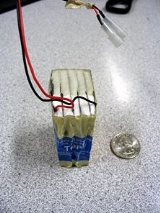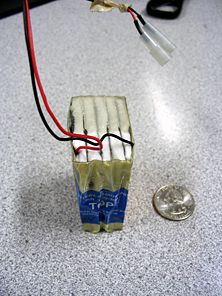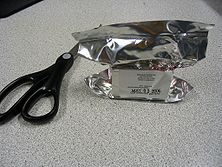
Water-activated battery
Encyclopedia
A water-activated battery is a disposable reserve battery
that does not contain an electrolyte
and hence produces no voltage
until it is soaked in water
for several minutes.

 Typically, a large variety of aqueous solution
Typically, a large variety of aqueous solution
s can be used in place of plain water. This battery type is specifically designed to be more environmentally friendly
due to an absence of heavy metals
. Water-activated batteries are used most commonly found in radiosonde
s which cannot contain heavy metals
because they regularly fall to the ground or ocean
surface and remain there indefinitely.
A carbon
-magnesium
battery, named NoPoPo, coming in AA
and AAA
sizes, was released in Japan
in 2007. The batteries come with a syringe
to inject water or electrolyte, such as juice. Diagnostic
kits using copper
-magnesium cells activated by water or the liquid sample itself are also in development.
However these batteries have failed to make an impact due to their extreme low power output and very short active life-span.
Moreover , due to the chemical reaction involving magnesium , these batteries are known to deform and cause damage to products used with these batteries.
Another water-activated battery had been invented by Susume Suzuki of Total System Conductor.
Aluminum
anode
s are used on many water-activated batteries designed for use with seawater
and its high salinity
.
A new kind of water-activated battery is the HydroPak, a portable power generator that uses water-activated disposable fuel cartridges. It is a high energy alternative to lead acid battery packs and portable generators that works by adding water to sodium borohydride
which releases hydrogen
fuel for a proton exchange membrane fuel cell
. It can be re-charged simply by replacing the fuel cartridge rather than the lengthy recharging that other batteries require, however the cartridges cost $20 each.
Reserve battery
A reserve battery, also called stand-by battery, is a primary battery where part is isolated until the battery needs to be used. When long storage is required, reserve batteries are often used, since the active chemicals of the cell are segregated until needed, thus reducing self-discharge...
that does not contain an electrolyte
Electrolyte
In chemistry, an electrolyte is any substance containing free ions that make the substance electrically conductive. The most typical electrolyte is an ionic solution, but molten electrolytes and solid electrolytes are also possible....
and hence produces no voltage
Voltage
Voltage, otherwise known as electrical potential difference or electric tension is the difference in electric potential between two points — or the difference in electric potential energy per unit charge between two points...
until it is soaked in water
Water
Water is a chemical substance with the chemical formula H2O. A water molecule contains one oxygen and two hydrogen atoms connected by covalent bonds. Water is a liquid at ambient conditions, but it often co-exists on Earth with its solid state, ice, and gaseous state . Water also exists in a...
for several minutes.
Description


Aqueous solution
An aqueous solution is a solution in which the solvent is water. It is usually shown in chemical equations by appending aq to the relevant formula, such as NaCl. The word aqueous means pertaining to, related to, similar to, or dissolved in water...
s can be used in place of plain water. This battery type is specifically designed to be more environmentally friendly
Environmentally friendly
Environmentally friendly are terms used to refer to goods and services, laws, guidelines and policies claimed to inflict minimal or no harm on the environment....
due to an absence of heavy metals
Heavy metals
A heavy metal is a member of a loosely-defined subset of elements that exhibit metallic properties. It mainly includes the transition metals, some metalloids, lanthanides, and actinides. Many different definitions have been proposed—some based on density, some on atomic number or atomic weight,...
. Water-activated batteries are used most commonly found in radiosonde
Radiosonde
A radiosonde is a unit for use in weather balloons that measures various atmospheric parameters and transmits them to a fixed receiver. Radiosondes may operate at a radio frequency of 403 MHz or 1680 MHz and both types may be adjusted slightly higher or lower as required...
s which cannot contain heavy metals
Heavy metals
A heavy metal is a member of a loosely-defined subset of elements that exhibit metallic properties. It mainly includes the transition metals, some metalloids, lanthanides, and actinides. Many different definitions have been proposed—some based on density, some on atomic number or atomic weight,...
because they regularly fall to the ground or ocean
Ocean
An ocean is a major body of saline water, and a principal component of the hydrosphere. Approximately 71% of the Earth's surface is covered by ocean, a continuous body of water that is customarily divided into several principal oceans and smaller seas.More than half of this area is over 3,000...
surface and remain there indefinitely.
A carbon
Carbon
Carbon is the chemical element with symbol C and atomic number 6. As a member of group 14 on the periodic table, it is nonmetallic and tetravalent—making four electrons available to form covalent chemical bonds...
-magnesium
Magnesium
Magnesium is a chemical element with the symbol Mg, atomic number 12, and common oxidation number +2. It is an alkaline earth metal and the eighth most abundant element in the Earth's crust and ninth in the known universe as a whole...
battery, named NoPoPo, coming in AA
AA battery
An AA battery is a standard size of battery. Batteries of this size are the most commonly used type of in portable electronic devices. An AA battery is composed of a single electrochemical cell...
and AAA
AAA battery
A triple A or AAA battery is a standard size of dry cell battery commonly used in portable electronic devices. A carbon-zinc battery in this size is designated by IEC as "R03", by ANSI C18.1 as "24", by old JIS standard as "UM 4", and by other manufacturer and national standard designations that...
sizes, was released in Japan
Japan
Japan is an island nation in East Asia. Located in the Pacific Ocean, it lies to the east of the Sea of Japan, China, North Korea, South Korea and Russia, stretching from the Sea of Okhotsk in the north to the East China Sea and Taiwan in the south...
in 2007. The batteries come with a syringe
Syringe
A syringe is a simple pump consisting of a plunger that fits tightly in a tube. The plunger can be pulled and pushed along inside a cylindrical tube , allowing the syringe to take in and expel a liquid or gas through an orifice at the open end of the tube...
to inject water or electrolyte, such as juice. Diagnostic
Diagnosis
Diagnosis is the identification of the nature and cause of anything. Diagnosis is used in many different disciplines with variations in the use of logics, analytics, and experience to determine the cause and effect relationships...
kits using copper
Copper
Copper is a chemical element with the symbol Cu and atomic number 29. It is a ductile metal with very high thermal and electrical conductivity. Pure copper is soft and malleable; an exposed surface has a reddish-orange tarnish...
-magnesium cells activated by water or the liquid sample itself are also in development.
However these batteries have failed to make an impact due to their extreme low power output and very short active life-span.
Moreover , due to the chemical reaction involving magnesium , these batteries are known to deform and cause damage to products used with these batteries.
Another water-activated battery had been invented by Susume Suzuki of Total System Conductor.
Aluminum
Aluminium
Aluminium or aluminum is a silvery white member of the boron group of chemical elements. It has the symbol Al, and its atomic number is 13. It is not soluble in water under normal circumstances....
anode
Anode
An anode is an electrode through which electric current flows into a polarized electrical device. Mnemonic: ACID ....
s are used on many water-activated batteries designed for use with seawater
Seawater
Seawater is water from a sea or ocean. On average, seawater in the world's oceans has a salinity of about 3.5% . This means that every kilogram of seawater has approximately of dissolved salts . The average density of seawater at the ocean surface is 1.025 g/ml...
and its high salinity
Salinity
Salinity is the saltiness or dissolved salt content of a body of water. It is a general term used to describe the levels of different salts such as sodium chloride, magnesium and calcium sulfates, and bicarbonates...
.
A new kind of water-activated battery is the HydroPak, a portable power generator that uses water-activated disposable fuel cartridges. It is a high energy alternative to lead acid battery packs and portable generators that works by adding water to sodium borohydride
Sodium borohydride
Sodium borohydride, also known as sodium tetrahydridoborate, is an inorganic compound with the formula NaBH4. This white solid, usually encountered as a powder, is a versatile reducing agent that finds wide application in chemistry, both in the laboratory and on a technical scale. Large amounts are...
which releases hydrogen
Hydrogen
Hydrogen is the chemical element with atomic number 1. It is represented by the symbol H. With an average atomic weight of , hydrogen is the lightest and most abundant chemical element, constituting roughly 75% of the Universe's chemical elemental mass. Stars in the main sequence are mainly...
fuel for a proton exchange membrane fuel cell
Proton exchange membrane fuel cell
Proton exchange membrane fuel cells, also known as polymer electrolyte membrane fuel cells , are a type of fuel cell being developed for transport applications as well as for stationary fuel cell applications and portable fuel cell applications. Their distinguishing features include lower...
. It can be re-charged simply by replacing the fuel cartridge rather than the lengthy recharging that other batteries require, however the cartridges cost $20 each.

